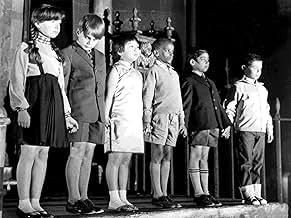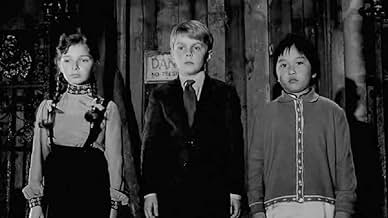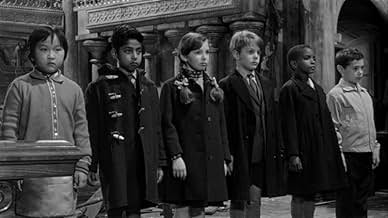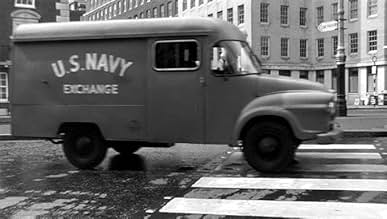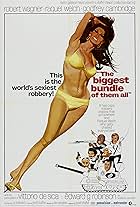Six impossibly intelligent children from all over the world with dangerous psychic powers hide in a church in England after the military tries to experiment on them. Besieged, they warn the ... Read allSix impossibly intelligent children from all over the world with dangerous psychic powers hide in a church in England after the military tries to experiment on them. Besieged, they warn the military to back off before carnage ensues.Six impossibly intelligent children from all over the world with dangerous psychic powers hide in a church in England after the military tries to experiment on them. Besieged, they warn the military to back off before carnage ensues.
- Awards
- 1 nomination total
- Russian official
- (as Andre Mikhelson)
- Mi Ling
- (as Lee Yoke-Moon)
- Director
- Writers
- All cast & crew
- Production, box office & more at IMDbPro
Featured reviews
Children of the Damned is generally considered to be a sequel to the excellent Village of the Damned; however, when viewed like this, glaring anomalies prevent it from being a fully satisfying experience. Children of the Damned is therefore best viewed as a standalone project; seen in this way, the film is more than worthy of any sci-fi/horror fan's time—an intelligent, thought-provoking piece that raises religious, ethical and philosophical debates and which, depending on how the somewhat ambiguous ending is interpreted, also delivers a prophetic warning: unless humans can overcome their innate distrust and fear of that which they do not understand, there can be no hope of survival for mankind.
Opinion about which of the 'of the Damned' films is better is seriously divided, but given the choice, I would always go for the freaky, blonde-haired and undeniably malevolent mutants of 'Village' over the normal looking, multi-cultural, and possibly benevolent saviours of mankind from 'Children'. Guess that's just how I roll...
These kids mean business!
Though this movie isn't quite as dark as its predecessor, VILLAGE OF THE DAMNED, it does offer political intrigue, a resurrection, and a cool secret weapon involving a pipe organ.
Highly recommended for fans of the original film...
This is a rare instance of a sequel being better than the original. The 1960 adaptation of John Wyndham's Midwich Cuckoos, filmed as Village Of The Damned, was a highly memorable and influential movie in its own right. However, it was also a product of post-war British film making complete with cozy, somewhat gentrified attitudes to class, sex and an illusory rural idyll. This was exemplified by George Sanders' typically suave performance as the smoking-jacket clad, martini sipping hero. Children Of The Damned is a much tougher affair. This time the action takes place in the dark, grim, urban backstreets of early sixties London - not so much swinging as downright gothic.
Rather than the aliens invaders of the first film, the children here are a human super-species, socially and intellectually incompatible with the rest of humanity. They don't seem to mean any harm, but their eerily cold and quiet presence provokes the authorities into a fearful contemplation of what they might do. John Briley's adult and intelligent script takes an insightful look at how our inherently insecure systems of authority might hunt and destroy that which merely suggests a challenge to their control.
The cast is excellent. Ian Hendry and Alan Badel as the two conscientious scientists trying to fathom the children's secret, are terrific. They bounce Briley's sometimes caustically witty lines between them with a delightful, naturalistic touch. The rest of the cast play it for keeps too, imparting a sense of urgency and, as with Alfred Burke's government man, icy menace.
The children themselves are surprisingly well played. No brattish over-acting here. Instead, the group of young, multi-racial actors exude a perfect sense of other-worldly calm, and, when necessary, chilling ruthlessness.
The film's technical credits are excellent. Cinematographer Davis Boulton's vivid black and white images ensure that Children of the Damned is one of the best photographed British films of the era. The special effects are simple (glowing eyes) but startlingly effective. The late, great Ron Goodwin was a composer best known for comedies and war films, but here he provided a subtler kind of score which suggests both the child-like and the ethereal. It was one of his best.
The main plaudits must go to director Anton M. Leader. His handling of actors, the imaginative staging and his pictorial compositions, particularly towards the climax, are outstanding. For example, the scene depicting a group of gunmen trying, somewhat disastrously, to capture (or kill) the children in a derelict church is a tour de force of tension and horror. Yes, horror. This movie may have children in it, but it isn't a children's film.
In all, this is much more than a quick cash-in sequel. It deserves credit for making an early stab at confronting the ethics of genetics, and for being, along with the Quatermass movies, that rare thing; a thought provoking, grown-up science fiction film.
Unlike the first film, however, the children are of different nationalities (not identical blonds, as the children in the first film) and they do not mature at an accelerated rate.
It's as if the basic premise (six superintelligent kids who are a threat to mankind) was reworked into a new story. The children are explained as being "quantum leaps in evolution" (not alien offspring, as in the first film). And yet the story never clarifies why they were all born at approximately the same time in different parts of the world (coincidence?). When one sympathetic government agent asks the children, "Why are you here?", the children reply "We don't know."
A line of dialogue by a major character, stating that the children are here to help mankind, was later edited from the film. Too bad.
Mankind, rather than the kids, are portrayed as the bad guys. Despite some confusion over these basic plot elements, director Anton M. Leader does deliver a clear message concerning the hate, fear, and intolerance which society feels towards anyone who doesn't "fit in", as well as the greed for power which nations feel in their efforts to gain dominance over each other.
Storyline
Did you know
- TriviaPaul does not speak until almost an hour into the movie.
- GoofsThe geneticist character David Neville says that parthenogenesis (development of an egg without fertilization by sperm) is only in algae and plants, which would just be a character error if that is all that was known at the time, but even in the time period of the movie, parthenogenesis had already been documented in animals.
- Quotes
Dr. Tom Llewellyn: At this very moment, they could be making all those men out there turn their guns on one another!
- Crazy creditsIn the opening credits: "A sequel to John Wyndham's "The Midwich Cuckoos." This is the novel the previous film was based on and not the film's title.
- ConnectionsFeatured in Nightmare Festival (1989)
Details
- Release date
- Country of origin
- Languages
- Also known as
- El germen de las bestias
- Filming locations
- Production companies
- See more company credits at IMDbPro
Box office
- Gross US & Canada
- $1,000,000
- Runtime1 hour 29 minutes
- Color
- Aspect ratio
- 1.85 : 1
Contribute to this page



